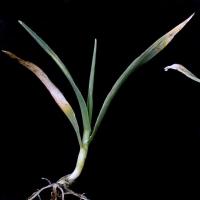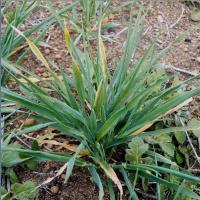Diagnosing phosphorus deficiency in barley
Nearly all soils in Western Australia are phosphorus deficient but continual use of phosphorus fertiliser means acute deficiency in broadacre crops is rare, with the exception of Darling Range gravels. Phosphorus deficiency is often transitory and compounded by dry soil with symptoms disappearing when the topsoil is re-wet following rainfall.
What to look for
- Smaller lighter green plants with necrotic leaf tips, generally on higher PBI parts of the paddock.
- Double sown areas have less symptoms if phosphorus fertiliser was used.
Paddock
- Tiller production and grain yield are reduced by mild deficiency where there are few symptoms apart from reduced growth and vigour.
- Fewer heads with less grain.
- Older leaves are affected first and most severely.
- Yellowing and death of leaf tips descends down the leaf but the lower leaf and stems remain green.
- Severely deficient plants may develop orange, red or purple colours and be stunted.
Plant
What else could it be
| Condition | Similarities | Differences |
|---|---|---|
| Diagnosing autumn winter drought in cereals | Dry soil can induce phosphorus deficiency in young plants | Symptoms disappear when the soil rewets |
|
Nitrogen, molybdenum or potassium
|
Small less tillered and light green plants. Similarities only occur for mildly deficient phosphorus plants | Severely phosphorus deficient plants are weak and thin with dull leaves and older leaf tip death. |
Where does it occur?

Soil type

Dry conditions
- Phosphorus deficiency is a problem on high phosphorus-retaining soils, particularly in the Darling Range where soil acidity and water repellence markedly reduce phosphorus uptake.
- Dry topsoil can lead to temporary phosphorus deficiency on all soils particularly during early crop growth and on water repellent soils.
- Water repellent and acidic soils require more phosphorus.
Management strategies

Top dressing

- Plants have a high requirement for phosphorus during early growth. As phosphorus is relatively immobile in the soil, topdressed or sprayed fertiliser cannot supply enough to correct a deficiency.
- Phosphorus is poorly mobile in most soils, but does move on very low PBI sands, particularly on coastal plains. Topdressing is effective on these soils, but deficiency is rare.
How can it be monitored?

Soil test


Tissue test
- Soil test to determine phosphorus fertiliser requirements. Soil tests may underestimate available phosphorus on very low PBI sands and overestimate it on acidic and water repellent soils (particularly in the Darling Range).
- Use whole-top plant test to diagnose suspected phosphorus deficiency, and compare paired good/poor plant samples where possible.
Further information
Where to go for expert help
Page last updated: Monday, 27 February 2017 - 12:33pm



